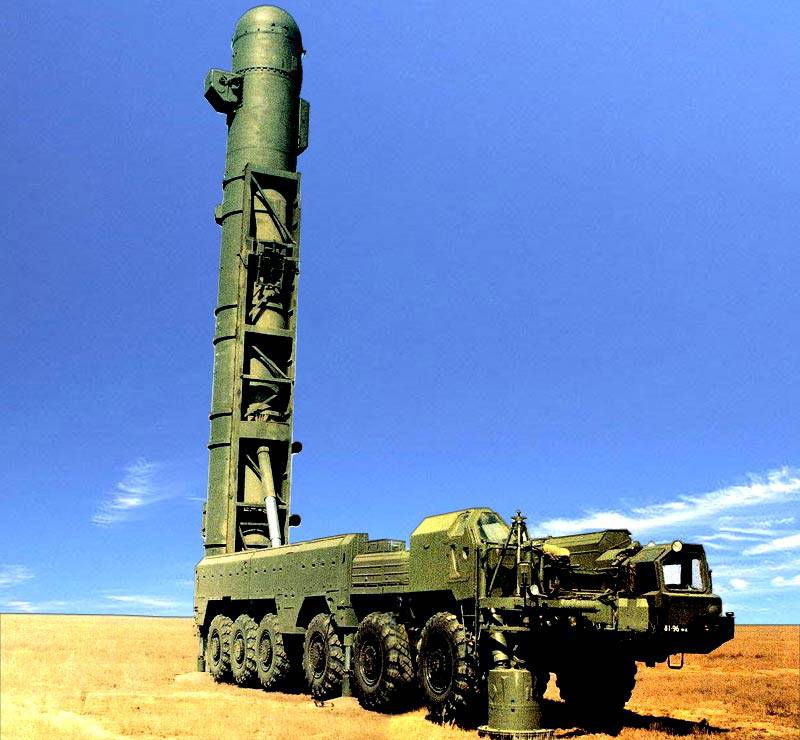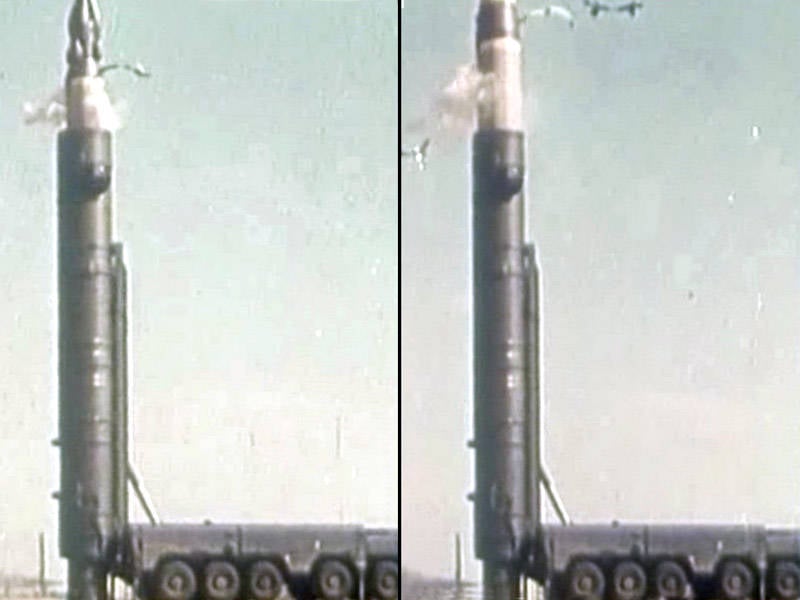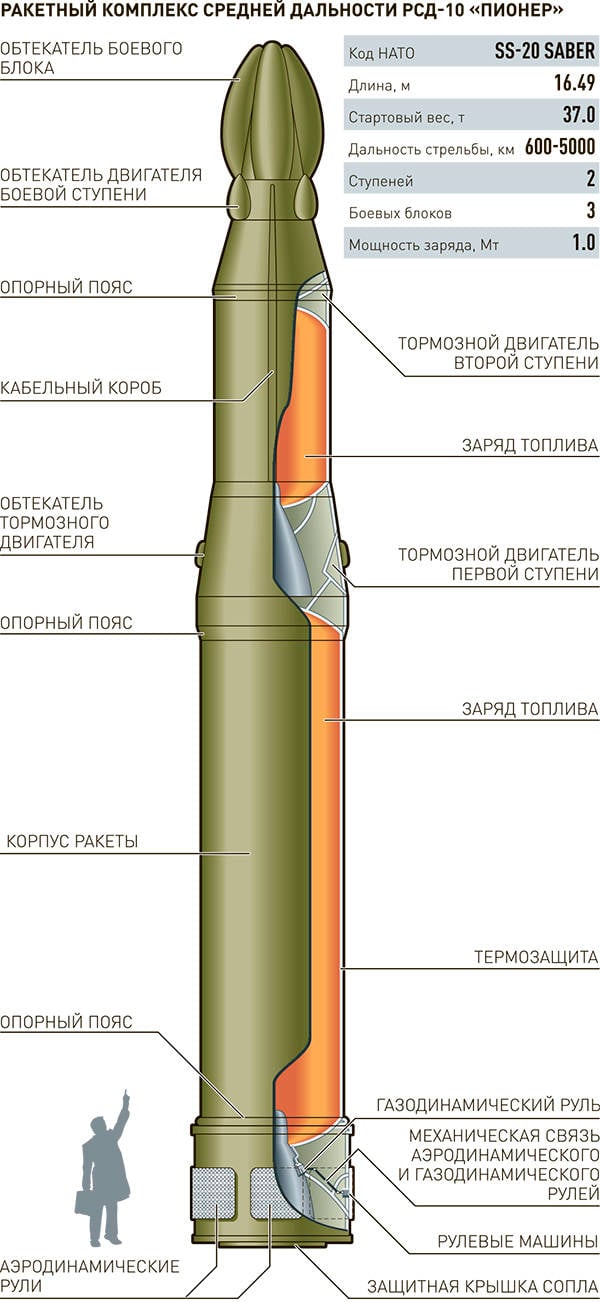RSD-10 “Pioneer” missile system

SPN 15U106 of the 15P645 "Pioneer" complex - SS-20 SABER in the pre-launch position (processing photos from the collection "Weapon Of Russia ", MilitaryRussia.Ru, 2011)
The development of the new missile system, which received the 15P645 index and the name “Pioneer” (later the designation RSD-10), was launched in 1971 at the Moscow Institute of Thermal Engineering (MIT) under the leadership of Alexander Davidovich Nadiradze. Engineers were required to create a new medium-range ballistic missile capable of hitting targets at ranges up to 4500-5000 km, and other elements of the missile complex, including a mobile launcher on a wheeled chassis. To simplify the creation of the missile system, it was proposed to take the Temp-2С intercontinental missile as a basis. As a basis for the "Pioneer" were used two upper stages of the previously developed rocket.
The lead developer of the new project was appointed MIT. In addition to this organization, the TsKB Titan, the Soyuz and other organizations were involved in the creation of various components of the promising missile system. In accordance with the decision of the Council of Ministers on April 20, 1973 was required to complete the design work and begin testing the complex by the middle of 74. Such terms were one of the reasons that a large number of elements of the complex were borrowed from the project Temp-2С with minor modifications.
Tests of the new Pioneer missile system started in the middle of 1974. Flight tests began on September 21 of the same year. Debugging and testing of the systems continued until the spring of 1976. 11 March 76-th State Commission signed an act of acceptance of the new missile system 16P645 with the rocket 15IX45 into the strategic missile forces. Soon began the delivery of new complexes to the troops.
The main elements of the mobile ground rocket complex 15P645 "Pioneer" were a ballistic missile 15Ж45 and self-propelled launcher 15Х106. Such architecture of the complex allowed patrolling away from the bases and, after receiving the order, to launch the rocket in the shortest time possible.
Self-propelled launcher 15U106 developed in Volgograd TsKB "Titan". The basis for this car was the chassis MAZ-547В with wheel formula 12х12. The total length of the launcher exceeded 19 m, the total mass of the complex (with the transport-launch container and rocket) - 80 tons. Thanks to the B-38 diesel engine with 650 horsepower. 15U106 could accelerate to 40 km / s. It was provided to overcome the rise to 15 °, the ditch wide to 3 m and the crossing of water obstacles with a depth of no more than 1,1 m ford.
The 15U106 launcher mounted a lifting unit with hydraulic drives, designed to install a launch vehicle (TPC) rocket and bring it to a vertical position before launch. The 15Я107 container was proposed to be manufactured from glass fiber reinforced with titanium rings. The design of the TPK was multi-layered; there was a layer of thermal insulation between the two fiberglass cylinders. The length of the TLC is 19 m. A typical hemispherical cover was attached to the front / upper container ends on pyrobolts, and a powder pressure pressure accumulator (PAD) housing, which provided a mortar launch, was attached to the rear / bottom ends.

The launch of the rocket 15Ж45. In the left picture you can see the shooting of the redox potential of the stage of reconnaissance of warheads, on the right - the shooting of the redox phase of the 1-th stage of the rocket. (Dyachok A., Stepanov I., Storen. Mobile medium-range soil rocket complex RSD-10 (РТ-21М) (SS-20 "Saber"). 2008 g.)
The launch of the Pioneer missiles of all modifications was carried out by the so-called. cold method. The product was thrown from TPC due to a powder charge in the bottom part of the container. For greater efficiency, the PAD case was made in the form of a cylindrical part attached to the WPC and a sliding glass inside it. During launch, the pressure of the powder gases PAD was supposed to affect the rocket, and also to push the body glass down. Sinking to the ground, this detail was supposed to serve as an additional support for the WPC. In case of abnormal burning of the powder charge, capable of destroying the rocket, the retractable glass was supposed to break through and relieve the pressure of the gases inside the TPC.
Inside the transport and launch container, the rocket of the Pioneer complex was held by means of detachable support-driving belts (AFP), also performing the functions of the obturator. Immediately after the release of the missile from the ORP container, they fired and flew to a range of at least 150-170 m, which imposed certain restrictions on the organization of group rocket launches from one site. In order to avoid damage to surrounding objects, a detachable cover of the WPC was attached to the launcher with a cable and had to fall in close proximity to it.
The first ammunition developed in the framework of the Pioneer project was the medium-range ballistic missile 15Ж45. It was created with extensive use of the developments and components of the Temp-2С missile complex developed earlier. The design of the rocket 15Ж45 consisted of two marching stages, the stage of breeding and instrument compartment. With a total length of 16,5 m, the rocket had a launch weight of 37 tons, the throwing weight was 1,6 tons.
The first stage of the rocket with a length of 8,5 m and a weight of 26,6 t was equipped with a solid-fuel 15-66 engine with a fiberglass hull, using composite fuel. To reduce the length of the rocket, the nozzle of the first stage engine was partially sunk into its body. It was proposed to control the operation of the engine using gas-jet rudders made of heat-resistant material. These rudders were coupled with resharp aerodynamic, located on the outer surface of the rocket. The engine had a cut-off system.
The design of the second stage with a length of 4,6 m and a mass of 8,6 t was similar to the architecture of the first stage. The second main stage was equipped with a solid-fuel 15-205 engine with a partially recessed nozzle. To change the flight range of the rocket, the second stage received a throttle cut-off system, which was designed anew, and not borrowed from the previous project. The flight control of the second stage was carried out using a system of gas rudders.
The rocket breeding stage 15ЖХNNUMX was equipped with four solid-fuel 45D15P engines with rotary nozzles. Small-sized engines were located on the side of the breeding stage, below the warheads. The combat equipment of the 69ЖХNNXX rocket consisted of three nuclear warheads of individual guidance with a power of 15 CT each. The warheads were located on the sides of the central cone of the instrument compartment and gave the head of the rocket a distinctive appearance. No means of overcoming missile defense were envisaged.
The 15IXX45 ballistic missile received an inertial guidance system developed by the Moscow NPO Automation and Instrumentation. The control system was based on the onboard computer and gyro-stabilized platform. The capabilities of the control system made it possible to introduce a flight task before the rocket was raised to a vertical position, and also provided the ability to fly in any direction regardless of the position of the launcher. During the flight, the on-board control system for the correction of the flight path consistently used the rudders of two stages and the engines of the breeding stage.
According to official data, the rocket 15Ж45 could deliver three combat units of individual guidance to a range of up to 4700 km. Circular probable deviation (QUO) did not exceed 550 m.
The launch of the Pioneer missile complex could be carried out both from the prepared open ground and from the Krona defense structure. The latter was a disguised garage with gates at both ends. On duty, the launchers of the Pioneer complex could enter such facilities and expect an order. Before launching with the help of squibs, the roof of the structure should have been dropped, after which the complex should be calculated with a missile and other preparatory operations should be carried out. For camouflage, the Krona facilities were equipped with electric furnaces. The building with operating furnaces in the infrared range had the same appearance as the “Krona” with the launcher inside. A relatively large number of defenses made it difficult to track the Pioneer missile complexes with reconnaissance satellites.
Regardless of the location of the launch procedure looked the same. Upon arrival at the position of the calculation had to hang out the launcher on the jacks and prepare the rocket for launch. All preparatory operations were performed automatically after the appropriate command. During the preparation for the launch, the cover of TPK was shot and the container was raised to a vertical position. At launch, the PAD gases were thrown at a rocket to a height of about 30 m, after which the AFP was shot and the first stage cruising engine was launched.
The mobile ground rocket complex 15P645 "Pioneer" was put into service in 1976 year. Serial production of missiles started a year earlier at the Votkinsk engineering plant. The first regiment, fully staffed by the Pioneers, took over duty in the summer of 1976 of the year. The Pioneer missile systems served in different regions of the USSR, which made it possible to “hold on sight” a multitude of targets in Europe, Asia and some parts of North America. At the same time, the Pioneer complexes of all modifications served mainly in the European part of the Soviet Union. The number of missiles deployed east of the Urals has never exceeded a few dozen. New missiles were replaced in the army with outdated weapons, such as the P-14 ballistic missiles.
It is known that over the years of service of the Pioneer complexes in the strategic missile forces, 190 launches were made. All launches were completed without serious problems or accidents and ended with the fall of warheads to the target area.
According to some information, the information about the appearance of new medium-range missiles at the Soviet Union caused quite a stir in the leadership of the NATO countries. In the documents of the North Atlantic Alliance, the Pioneer complex appeared under the designation SS-20 Saber. In addition, it is known about the existence of an unofficial nickname "The Thunderstorm of Europe", due to the tactical and technical characteristics of the complex.
Having completed the development of the 15ЖХNNX rocket, the unification of several organizations headed by the Moscow Institute of Thermal Engineering was engaged in the improvement of this product. In August, the 45 of the year began flight tests of the upgraded 1979Ж15 rocket. Testing and finishing rocket took about a year. In December 53, the 1980P15 “Pioneer-653” or “Pioneer-UTTH” complex (“Improved tactical and technical characteristics”) with the 2ЖХ15 rocket was put into service.
The first and second stages of the upgraded rocket remained the same. All changes concerned only the control unit located in the housing of the breeding stage. The use of new electronic equipment as part of the control system made it possible to reduce the CER to 450 m. In addition, some sources mention the use of upgraded engines for the dilution stage, which made it possible to increase the allowable distance between the attacked targets.
In the mid-eighties, the USSR and the USA, realizing the danger of medium-range and short-range ballistic missiles, began negotiations, the purpose of which was to be a new international agreement. The result of these consultations was the Treaty on the Elimination of Medium and Small-Range Missiles, signed in December 1987 and entered into force in the middle of 88. The agreement implied a complete rejection of missile systems with a firing range from 500 to 5500 km. PCD-10 / 15П645 / 15П653 “Pioneer” complexes were covered by the contract, as a result of which their utilization began.
According to reports, over several years of production, more than 520 self-propelled Pioneer launchers were built, although at the time of signing the contract only 405 units with 405 missiles were deployed. In total, the troops at that time had 650 missiles. In accordance with the contract, by the end of 1988, the Pioneer complexes began to be removed from duty and disposed of. The latest missiles, launchers and other elements of the 15P645 and 15P653 complexes were destroyed in the spring of 1991.
Currently, four launchers and TPK complex "Pioneer" are museum pieces. Two samples are stored in Ukrainian museums: in the Military-Historical Museum of the Air Forces of the Armed Forces of Ukraine (Vinnitsa) and in the Museum of the Great Patriotic War (Kiev). Two more copies are available in Russian museums: in the Central Museum of the Armed Forces (Moscow) and in the museum of the Kapustin Yar test site (Znamensk). In addition, several 15ЖХ45 missiles became museum exhibits. The remaining launchers and missiles were destroyed.

The Pioneer missile system was distinguished by high mobility, could be quickly brought into combat and retargeted to higher priority targets. The range of the missile complex "Pioneer" is 5 500 kilometers. The warhead could carry a one megaton nuclear charge.
Source: Infographics: Leonid Kuleshov / Artem Lebedev / Nikita Mityunin / RG
On the materials of the sites:
http://rbase.new-factoria.ru/
http://kapyar.ru/
http://vpk.name/
http://rvsn.ruzhany.info/
http://militaryrussia.ru/blog/topic-381.html
Information